Best Internet Providers for Gaming in 2025
AT&T Fiber delivers fast internet speeds to keep up with gamers, all for a low price.
Gaming has quickly become one of the most popular activities in the world, with millions of people connecting with their friends digitally via multiplayer games. Many players even stream these games through social media platforms such as Twitch. Every gamer who has experienced lag or has had to wait hours for a new game to download, however, knows online gaming isn’t fun without a fast internet connection. Whether you’re a dedicated online gamer with a robust PC build or a casual RPG fan, we gathered our top internet service providers (ISPs) to help you choose the best option for your gaming needs based on availability, speed, value, reliability and reputation.
BroadbandNow Bottom Line
For an internet connection with no lag and low latencies the best internet provider for gaming is AT&T Fiber. With plenty of speed up to 5 Gbps, prices starting at $55 per month and award-winning customer service, AT&T Fiber delivers a performance that tops the leaderboards. Check out the latest AT&T internet deals to find the plan that matches your home’s needs.
Navigating the Best No-Contract Internet Providers
- AT&T (BroadbandNow Top Pick)
- Xfinity (Next-Best ISP for Gaming)
- Spectrum (Budget Pick)
- Our Top ISP for Gaming Recommendations
- Why You Should Pick an ISP for Gaming
- How We Chose Our Favorite Internet Provider for Gaming
- Methodology for Assessing Internet Providers
- Other Internet Providers for Gaming Worth Mentioning
- Tips for Picking the Perfect Internet Provider for Gaming
- Frequently Asked Questions About Internet Providers for Gaming
AT&T Fiber (BroadbandNow Top Pick)
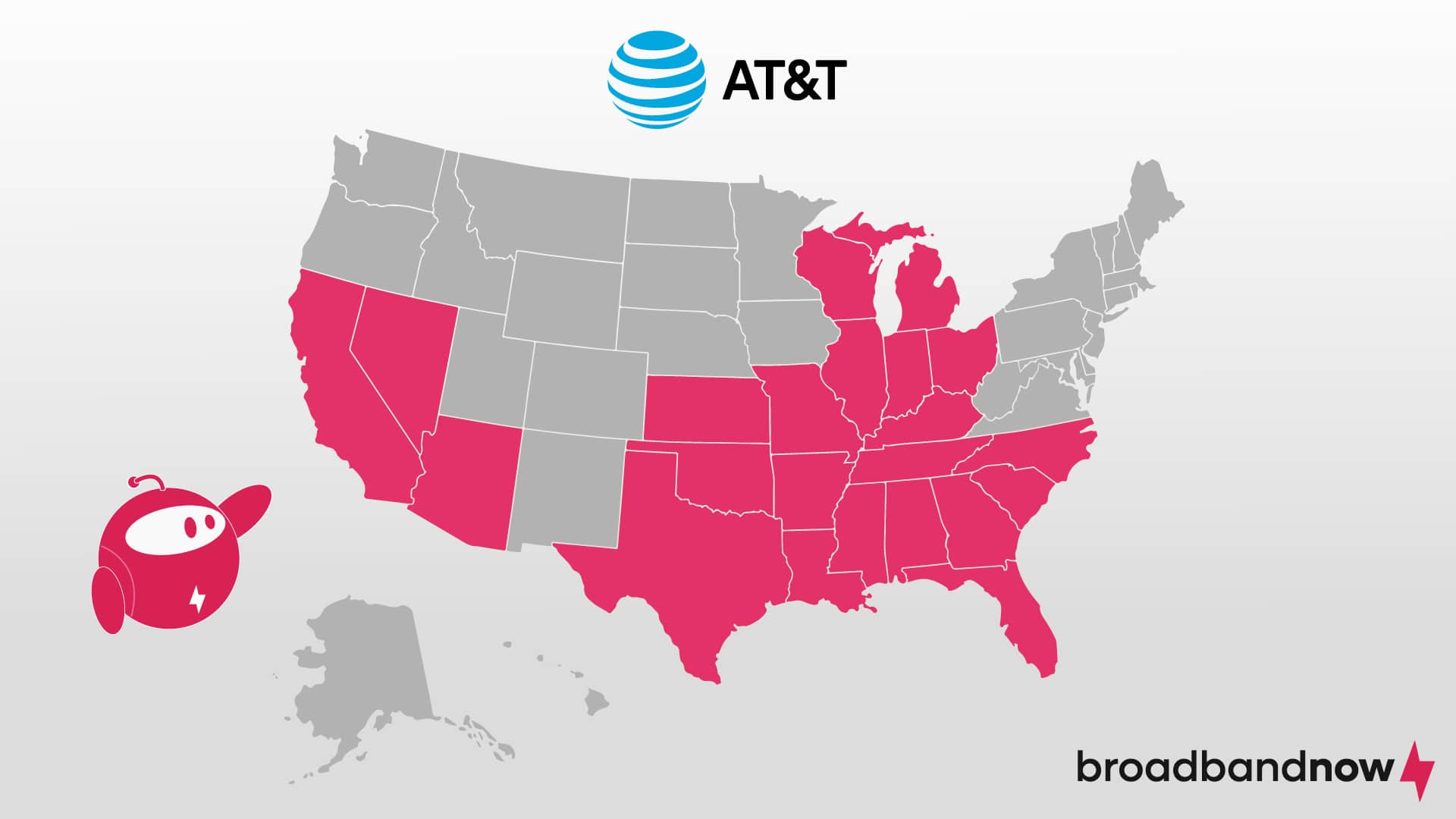
With fast internet speeds, unlimited data caps and excellent customer service, AT&T is our top choice for gamers who want the best internet experience. AT&T offers a variety of internet types, from fiber to 5G home internet. AT&T is known primarily for a blazing-fast fiber internet connection, which offers speeds up to 5 Gbps. With quick speeds and prices starting at just $55 per month, gamers will enjoy a crisp, low-latency and affordable gaming experience with AT&T Fiber.
Every AT&T internet plan comes with unlimited data, a huge perk for the dedicated gamer in your household, as plans with no data caps allow them to download and stream games to their heart’s content. If they’re looking to post videos online, they’ll also be able to upload as much video content as they like without waiting hours.
Even with top internet, a solid internet provider should have good customer service, especially if there are any outages or issues with lag. AT&T features renowned customer support and provides multiple avenues of contact, including calling by phone or using live chat. AT&T even offers forums where gamers can ask other users about fiber internet and other general inquiries.
What We Like
- Ultrafast fiber internet speeds for no-lag gaming
- Unlimited data for endless game downloads
- Award-winning customer service
What We Don't Like
- Lack of bundle options
- No Wi-Fi 7 router
Xfinity (Next Best ISP for Gaming)
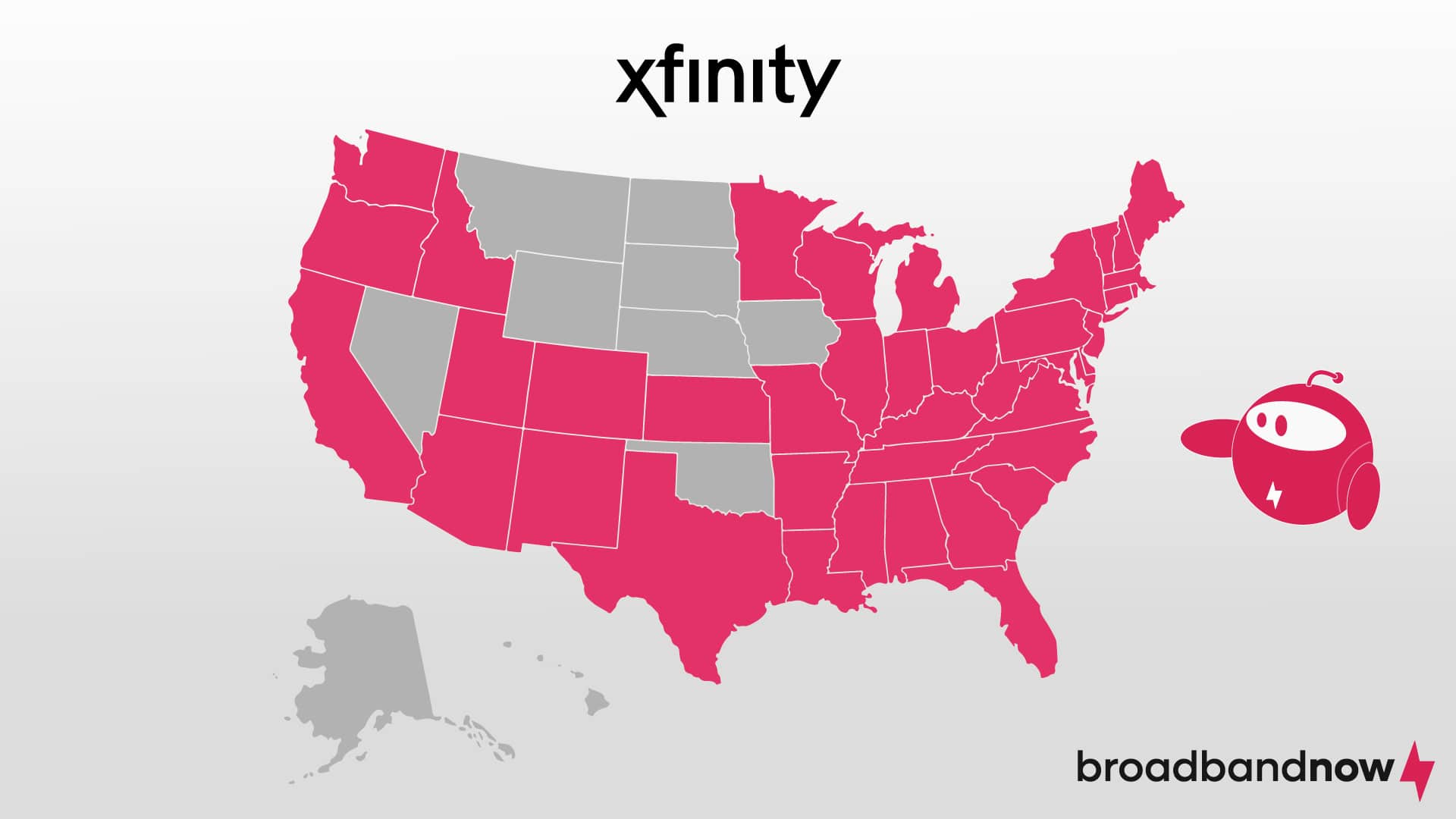
Xfinity’s fast cable internet and affordable pricing are just two reasons it’s one of our top ISPs for gamers. Although most Xfinity internet plans don’t offer unlimited data like other providers, their general data cap is generous, providing 1.2 TB of data for your activities. With online game downloads averaging 1 GB to 10 GB (unless you’re downloading “Call of Duty: Warzone”) and the download speeds eating up a negligible amount of data, Xfinity’s data cap should be enough for most gamers to download and enjoy their favorites without worrying about data overage fees.
While Xfinity does have some fiber internet offerings, they primarily deal in cable technology. Even though cable isn’t as fast, it still provides gigabit speeds and low latency, which is enough for most online gaming activities. Xfinity’s cable internet network can achieve speeds up to 1 Gbps. Fiber internet can be costly, especially if you’re purchasing gigabit internet. With cable internet, gamers can still get fast internet speeds at a fraction of the cost of most fiber internet plans. It won’t be as fast, but it’s an excellent budget-friendly option that balances speed and price. Xfinity cable internet plans start at just $30 per month.
What We Like
- Affordable pricing and value for speed
- Generous data cap for all cable internet plans
- Multiple bundle savings options
What We Don't Like
- Imposes data caps
- Some plans require a contract.
- Limited fiber availability
Spectrum (Budget Pick)
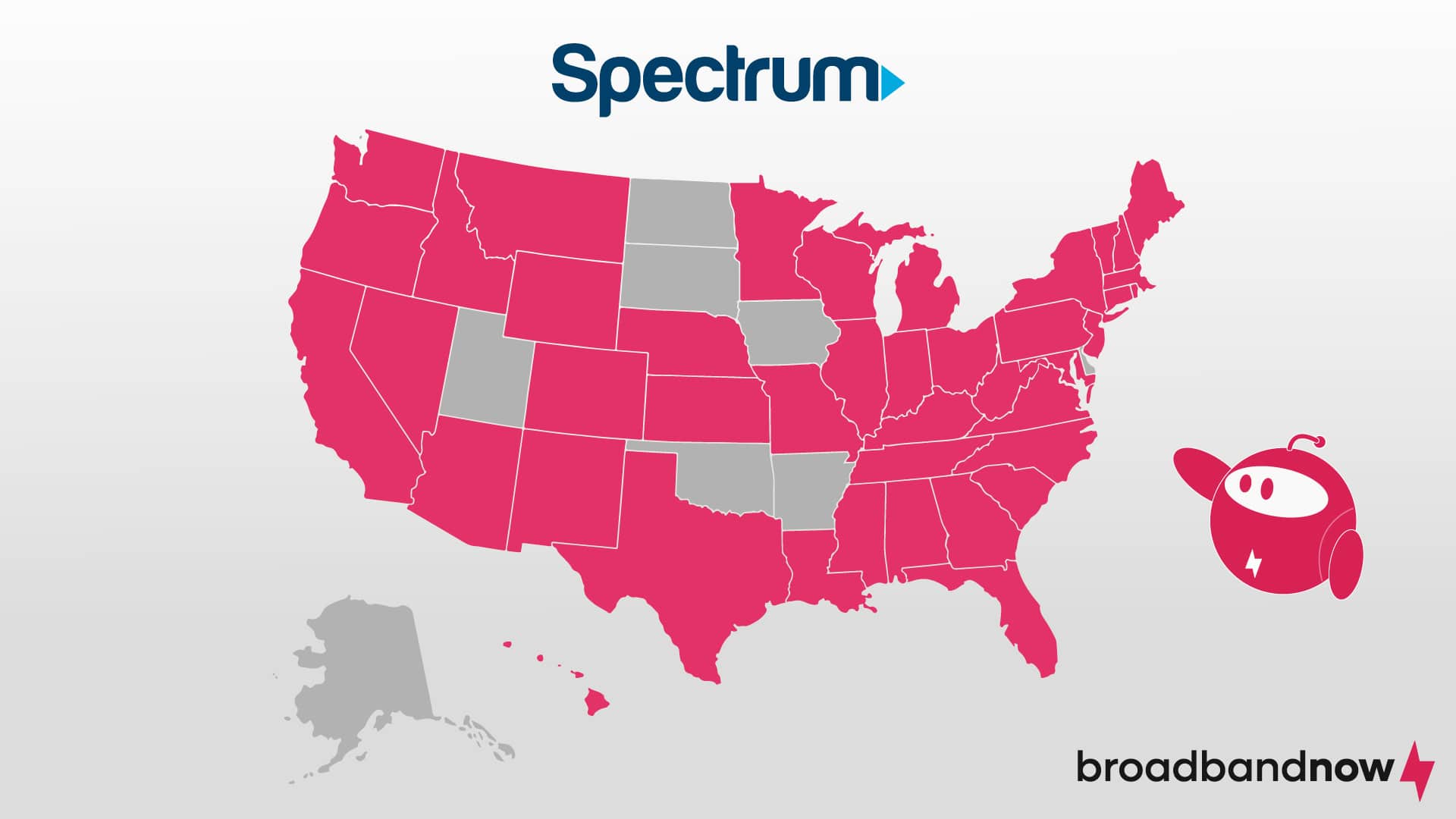
For a budget-friendly internet option with unlimited data and no contracts, Spectrum has you covered. Compared to AT&T and Xfinity, Spectrum offers some of the cheapest internet plans on the market when you consider its plan selection. Spectrum’s cable internet is affordable, priced at just $30 per month, and it offers unlimited data with speeds up to 1 Gbps. If you have multiple online gamers or streamers in your household, Spectrum’s unlimited data ensures you won’t go over a set limit. Livestreaming and downloading games can eat up bandwidth quickly, so unlimited data plans can help you alleviate some of the stress associated with data overage fees or having to watch how much data you use per month.
One of Spectrum’s best perks is that it doesn’t require contracts for any of its plans. Rather than committing to a contract that could last a year or two, Spectrum users can pay for their internet monthly and not worry about early termination fees (ETFs). Gamers can also take advantage of this benefit by switching between different plans to accommodate their internet needs. As a Spectrum customer for over five years, I have found the service reliable, as I’ve experienced very few outages over the years. When outages have occurred, they’ve been quickly resolved.
What We Like
- Unlimited data for gaming and streaming
- Budget-friendly cable internet plans
- No contracts required
What We Don't Like
- Service may vary based on time of day
- Nonsymmetrical speeds
Our Top ISP for Gaming Recommendations
| Details | BroadbandNow Top Pick | Next Best Gaming ISP | Budget Pick |
|---|---|---|---|
| Provider name | AT&T Fiber | Xfinity | Spectrum |
| Starting price | $55 per month | $30 per month | $30 per month |
| Download speeds (up to) | 5 Gbps | 1 Gbps | 1 Gbps |
| Activation fee | None | None | $35 (self-install) |
| Equipment fee | None | $15 per month | $5 per month |
| Installation fee | $99 | $39.99 (self-install), $100 (professional) | $65 |
| Data caps | No | 1.2 TB | No |
| Contracts | No | Yes | No |
| Bundle options | Home phone or mobile phone | TV, home phone, mobile phone or home security | TV, home phone or security software |
| More info | View AT&T Fiber Deals | View Xfinity Deals | View Spectrum Deals |
Why Internet Providers for Gaming Could Be Right for You
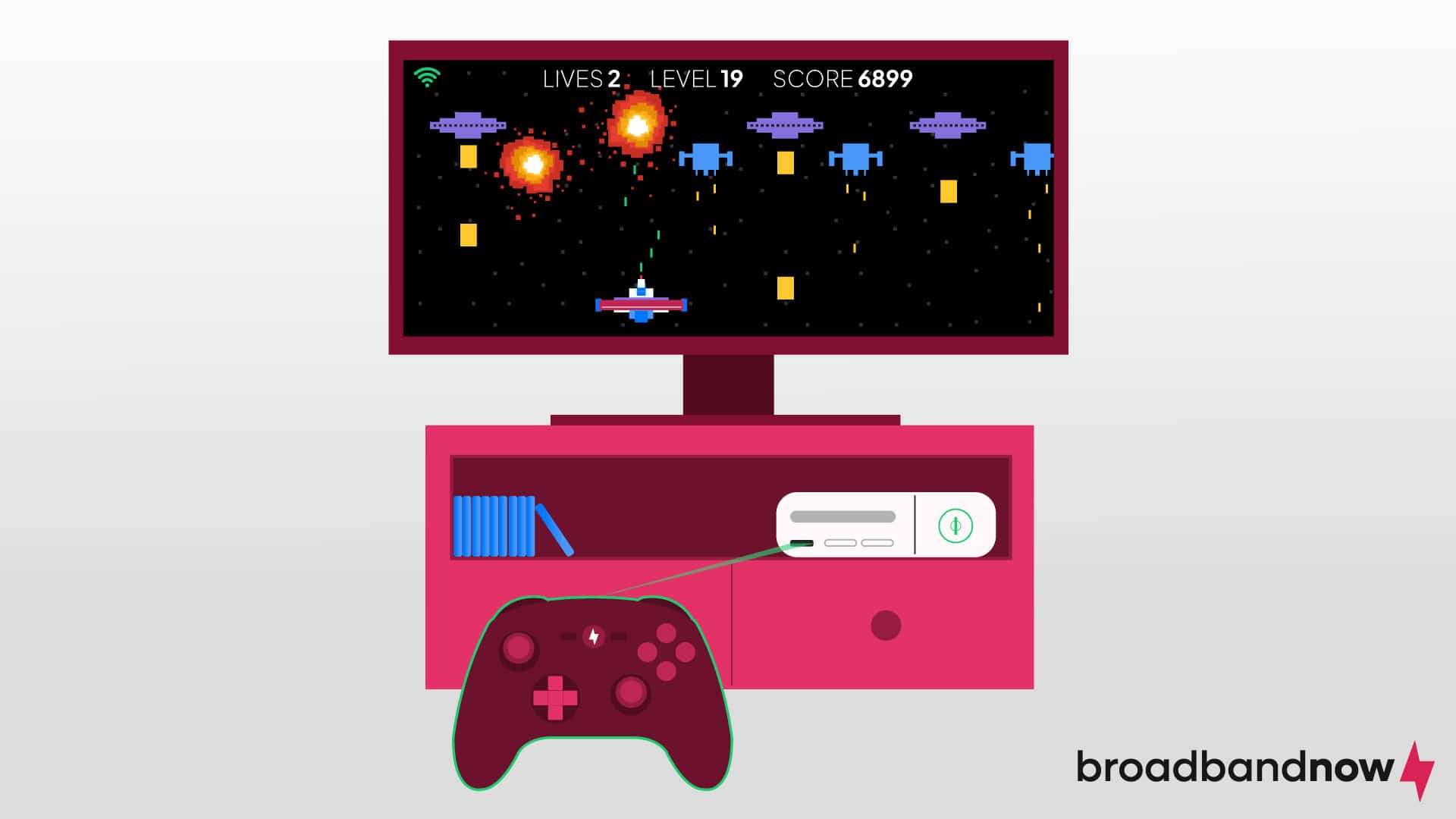
While casual internet users tend to look for the basics, gamers typically have more intense requirements for internet plans. For example, gamers who enjoy single-player games will want to make sure their internet plan can handle downloading the game. Multiplayer gamers, on the other hand, are usually more focused on aspects such as latency and speed; this ensures they get the best hit registry while staying connected to teammates via voice chat. No matter what type of gamer you are, here are the main things you need to look for in an internet plan for gaming:
- Fast download speeds. There are two central installation steps to set up a game: installing the game itself and installing its updates. While it’s not required to have gigabit-speed internet for video games, having the fastest internet speeds possible will allow you to download and play games faster. We recommend a minimum of 100 Mbps to ensure you can download games quickly and maintain your connection — but the faster, the better.
- Quick upload speeds. Some gamers like to upload their game footage on YouTube or stream live on platforms like Twitch. If this scenario sounds like you, consider upload speeds when looking for the ideal internet provider. Quick upload speeds ensure you can get your video content up quickly and that your video on demand (VOD) will run smoothly and without latency issues. We recommend upload speeds of at least 35 Mbps for gamers who want to livestream and post gameplay online.
- Low latency. Latency, also known as “ping,” describes how fast you receive a response from your internet connection after you send a request. In the gaming world, it describes the delay between your actions in the game and what appears on screen. Ideally, gamers who want smooth gameplay will want the lowest latency possible. We recommend looking for connections offering latency lower than 25 ms to prevent any multiplayer lag.
- Large data caps or unlimited data. Most video games are relatively small, usually under 1 GB to 2 GB. Some game developers release updates or downloadable content (DLC) to accompany these games, upping the total game size to a manageable 3 GB to 5 GB. That said, some online games can reach between 30 GB to 100 GB or larger. Downloading games alone can eat up data rapidly, so choosing an internet plan with a larger data cap (1 TB or more) is essential. And, if you can find it, unlimited data is the best option.
- A wired internet connection. You can play your games via Wi-Fi and experience decent internet speeds. However, we recommend getting a wired internet connection such as fiber or cable for the best experience. Not only do these connection types offer low latency, but they’re quick for both downloading and uploading. We suggest connecting directly to your router or modem via Ethernet for the best possible experience.
How We Chose Our Favorite Internet Providers for Gaming
As a gamer, choosing an internet provider comes with reviewing many more features than the average home internet user. With a need for quality speed and reliable service, gamers need to ensure the internet provider they pick can keep up with their online activities. We used these key factors to choose our top picks:
- Availability: Finding an internet service provider in your area that delivers the features you need is essential. We chose providers with wide availability across the United States to suit the needs of gamers across the country.
- Speed: Internet speed is one of the most important things gamers require in their internet service. To meet the minimum standards for gamers, we only considered internet providers that offer plans exceeding the Federal Communications Commission’s new definition of broadband (100 Mbps download/20 Mbps upload). Most gamers will require even higher speeds, and we chose providers that offer robust plans.
- Value: Balancing value with quality service shouldn’t be a challenge. We reviewed internet providers with quick speeds at a reasonable price. Our top picks feature quality internet plans starting at less than $60 per month, with reasonably priced options for upgraded plans.
- Reliability: No matter what time of day you’re gaming, you need a reliable connection to prevent dropped signals. All of our top picks are reputable internet providers known for providing reliable internet service to customers across the country.
- Reputation: Customer service issues can sometimes be par for the course for household utilities, and internet is no different. Finding a provider that can properly handle any customer service problems with ease ensures that the internet experience doesn’t leave a bad taste in your mouth.
Methodology for Assessing Internet Providers

Firsthand engagement with an internet provider is unparalleled in determining their reliability. From installation to customer service nuances, it’s the best method for accessing vital insights for an impartial evaluation of internet providers. This is why we thoroughly tested all major U.S. internet providers (alongside numerous smaller ISPs). Our aim was to equip you with direct feedback, ensuring you can make the optimal decision regardless of your location or the internet providers available to you. However, our efforts didn’t end there.
In addition to our direct experiences, we relied on data from diverse sources to rank these services. We meticulously scrutinized reports and research from the FCC and tapped into the FCC’s Broadband Data Collection for insights into ISPs. We engaged directly with internet providers to obtain the latest information on plans, pricing, promotions and availability. Our dedicated data collection team reviews intricate details such as fees and price adjustments. BroadbandNow Research dives into ISP claims, producing reports and forged partnerships with key broadband entities such as Microsoft and the NTIA to provide insightful perspectives on the broadband landscape. Furthermore, we sought input from renowned services such as the American Customer Satisfaction Index (ACSI), J.D. Power and the Better Business Bureau (BBB) – along with direct user feedback – to gauge customer sentiment regarding internet provider performance.
Other Internet Providers for Gaming Worth Mentioning
The internet providers we’ve listed below are great alternatives if our top providers aren’t available to you. Although each provider has drawbacks, there are still good perks associated with each provider.
- Verizon Fios: Verizon’s fiber internet service, Verizon Fios, is an outstanding option for gamers that offers symmetrical speeds up to 2 Gbps and unlimited data. If you’re outside the coverage area of other fiber internet providers, such as AT&T, you’ll want to sign up for Verizon Fios.
- Optimum: Outside of Xfinity and Spectrum, Optimum is an excellent alternative for cable internet. Optimum provides a cable internet connection with speeds up to 8 Gbps for prices starting as low as $40 per month, and it comes with multiple bundle options.
- Cox: Another well-known cable internet provider is Cox. With a large coverage area, generous data caps and quick speeds, Cox delivers high-quality internet to subscribers across the U.S. One of our favorite features of Cox internet is its smart home and mobile add-on options, but you will face a data cap of 1.25 TB.
- Astound Broadband: Despite their limited service area, Astound Broadband does boast quality multi-gig cable speeds for a reasonable monthly price. The provider also has a special perk for gamers: the option to rent a gaming router.
- Frontier: Fiber connections are generally preferred for gamers, and Frontier Fiber offers a quality connection for those in Frontier’s service areas. The provider features plans up to 7 Gbps to get gamers that high speed without overpaying.
Tips for Picking the Perfect Internet Provider for Gaming
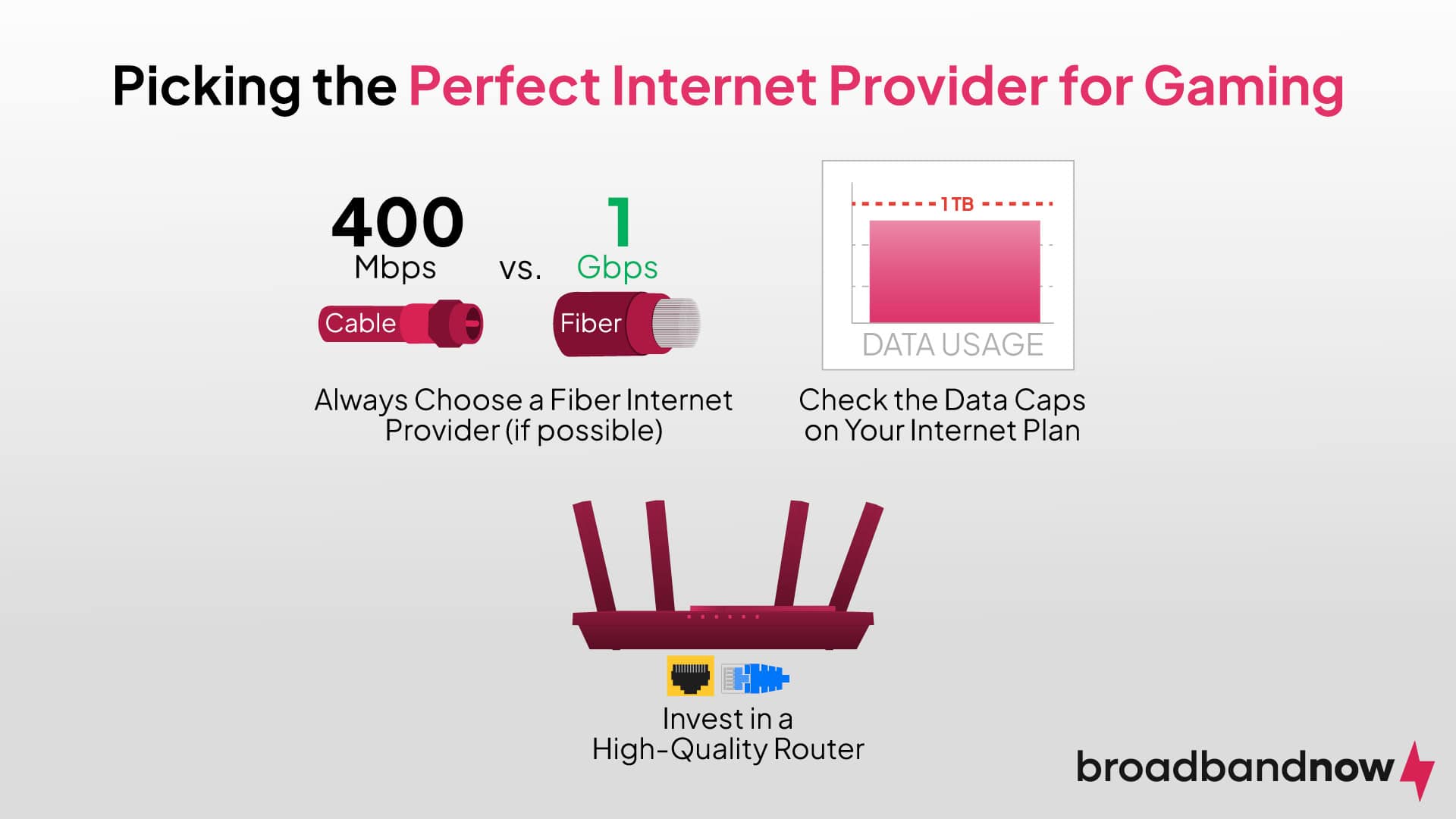
Picking the internet provider with the fastest internet speeds can be tempting, but there’s more to a good gaming internet plan than just speed. Here are some additional tips for choosing an internet provider for gaming:
- Always choose a fiber internet provider (if possible). Fiber internet provides symmetrical download and upload speeds, making gaming and streaming a breeze. It also offers fast internet speeds with little to no latency compared to other connection types.
- Check the data caps on your internet plan. Some internet providers offer unlimited data with their plans, while others impose a data cap. Check each plan carefully to see which one applies, and then compare that with how often your household plays games, noting the sizes of games you usually download as well.
- Invest in a high-quality router. A good router can make the difference between a good gaming session and a lagging solo-player mission. If you’re gaming on fiber or cable internet, choosing a quality router will also provide smooth gameplay when connected directly via Ethernet cable.
Frequently Asked Questions About Internet Providers for Gaming
Which internet provider offers the best internet plan for gaming?
We recommend AT&T Fiber as the best overall internet provider for gamers. They offer some of the fastest internet speeds on the market and provide outstanding customer service. If AT&T Fiber is unavailable in your area, we recommend looking into Xfinity or Spectrum.
What internet speeds do you need for gaming?
Fortunately, you don’t need gigabit internet to enjoy your favorite games. The minimum internet speed requirements for gaming are low (25 Mbps to 50 Mbps). However, gamers who use voice chat or frequently play multiplayer games will want higher internet speeds to prevent lag spikes or random disconnects. We recommend choosing a plan above 100 Mbps to get started.
Why is fiber internet the best option for gaming?
Fiber internet offers the fastest download and upload speeds on the market, making it ideal for gaming or cloud-based streaming. Generally speaking, wired internet options are the best for gaming because their connections allow users to play games at the highest quality without compromising internet speeds. In addition, fiber internet speeds are symmetrical, meaning that the download speeds are just as fast as the upload speeds.
What’s a good ping for online gaming?
Gamers can enjoy the best experience with pings below 25 ms. Players with latencies above 100 ms will experience frequent lag spikes and possible disconnects. This is one reason we don’t recommend satellite internet connections for multiplayer gaming.


